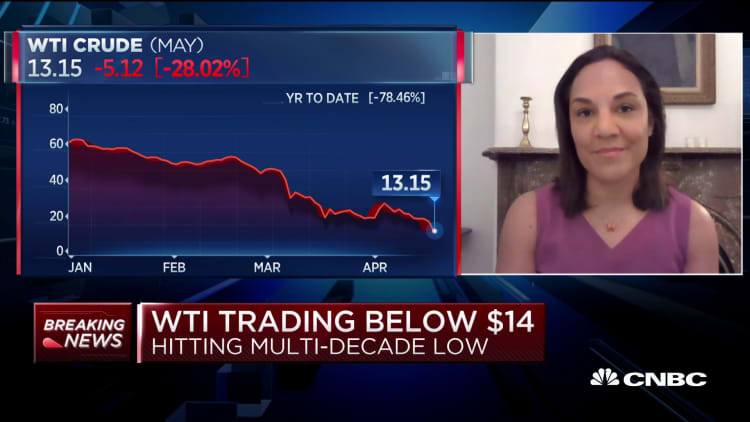
A futures contract for U.S. crude prices dropped more than 100% and turned negative for the first time in history on Monday, showing just how much demand has collapsed due to the coronavirus pandemic.
But traders cautioned that this collapse into negative territory was not reflective of the true reality in the beaten-up oil market. The price of the nearest oil futures contract, which expires Tuesday, detached from later month futures contracts, which continued to trade above $20 per barrel.
West Texas Intermediate crude for May delivery fell more than 100% to settle at negative $37.63 per barrel, meaning producers would pay traders to take the oil off their hands.
This negative price has never happened before for an oil futures contract. Futures contracts trade by the month. The June WTI contract, which expires on May 19, fell about 18% to settle at $20.43 per barrel. This contract, which was more actively traded, is a better reflection of the reality in the oil market. The July contract was roughly 11% lower at $26.18 per barrel.
The international benchmark, Brent crude, which has already rolled to the June contract, settled 8.9% lower at $25.57 per barrel.
The front part of the oil futures 'curve,' which is the May contract that expires on Tuesday, was hit the hardest since it applies to fuel that's set to be delivered while most of the country remains on lockdown thanks to the coronavirus. The only buyers of oil futures for that contract are entities that want to physically take the delivery like a refinery or an airline. But demand has dropped and storage tanks are filled, so they don't need it.
"There is still a lot of crude on the water right now that is going to refineries that do not need it," Helima Croft, global head of commodities strategy at RBC Capital, said Monday on CNBC's "Squawk Box". "Right now we don't see any near-term relief for this oil market … we remain really concerned for the outlook on oil near-term," she added.
The spread between the May and June contracts — known as the front month and second month — is now the widest in history, according to KKM Financial's Jeff Kilburg. "This is a phenomenon due to the expiration of the front month contract coupled with the historic plunge in crude," he said in an email.

The coronavirus pandemic has dealt a severe blow to economic activity around the globe and sapped demand for oil. While OPEC and its oil-producing allies finalized a historic agreement earlier this month to cut production by 9.7 million barrels per day beginning May 1, many argue that it still won't be enough to counter the fall-off in demand.
The International Energy Agency, for instance, warned in its closely-watched monthly report, that demand in April could be 29 million barrels per day lower than a year ago, hitting a level last seen in 1995.
"The real problem of the global supply-demand imbalance has started to really manifest itself in prices," Rystad Energy's head of oil markets Bjornar Tonhaugen told CNBC in an email. "As production continues relatively unscathed, storages are filling up by the day."
Contract expiration
ANZ's Daniel Hynes told CNBC's "Squawk Box" on Monday that one of the reasons behind the "crater" in U.S. crude prices is the impending expiration of the May futures contract on Tuesday. Front month futures contracts typically converge with spot prices as they near expiry.
"There will be traders in the market who only want to trade the paper, so they will roll over into the next futures contract. That means selling the May contract and buying the June," Hynes, who is a senior commodity strategist at ANZ, told CNBC in a follow-up email exchange.
"But there are also traders who are buying for clients who trade the physical. So they hold the contract to expiry and deliver the crude," or accept the crude if they are on the other side of the trade, he said.
This could be why there's a steeper fall in the May futures contract compared to the June contract. Spot prices are "particularly weak" at the moment, Hynes said, due to a combination of a "collapse in demand and a subsequent lack of storage."
In a normal market, the spread between the spot price and the one month forward futures contract "may only be around 40-50 cents per (barrel)," he said. "At the moment, it's been as high as $8-10 (per barrel)."
Hynes said that prices are likely to "remain under pressure" over the next month or so.
With demand at near-paralysis, oil and fuel tanks around the world are close to brimming — a stark evidence of the global glut and a function of the "contango" structure of the futures market, where contracts for later delivery trade at a premium to the front-month.
That's led to a dash by traders to lease floating or onshore storage in a bid to sell the fuel for a profit when prices rebound.
Global oil storage is "rapidly filling – exceeding 70% and approaching operating max," Steve Puckett, executive chairman of TRI-ZEN International, an energy consultancy, told CNBC earlier this month.
— CNBC's Sri Jegarajah contributed to this report.



